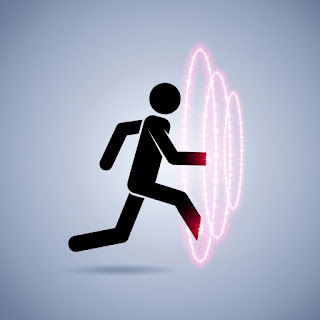In 2005, the necrology of physicist Asher Peres in Physics
Today magazine told us that when a journalist asked him if quantum teleportation
could hold a person's soul as well as their body, the scientist replied:
"No, not the body, only the soul." More than only a simple joke,
Peres' answer gives a perfect description, embedded in a metaphor, of the
nature of a phenomenon we've seen.
Teleportation in real science started to take shape in 1993,
thanks to a theoretical analysis published in Physical Review Letters by Peres
and five other researchers, setting the framework for quantum teleportation. Apparently,
it was the idea of co-author Charles Bennett to equate the proposed phenomenon
with the common concept of teleportation, but there is an essential difference
between fiction and reality: in the latter, traveling is not important, but
material, which transfers properties from the original matter to that of the
destination matter.
Quantum teleportation is based on a hypothesis that
physicist Albert Einstein and his colleagues Boris Podolsky and Nathan Rosen
described as the EPR paradox in 1935. As a result of the laws of quantum
physics, two particles could be obtained and separated in space to continue
sharing their properties as two halves of a whole.
Therefore, an action on one of them (on A, or Alice,
according to the nomenclature used) will immediately influence the other (on B,
or Bob). This "spooky behavior at a distance," in Einstein 's words,
would appear capable of exceeding the limit of light speed.
This phenomenon 's theory, called quantum entanglement, was
later developed by John Stewart Bell in 1964 and supported by numerous
experiments. Peres, Bennett and their collaborators' work proposed that a third
particle might interact with Alice's and lose a quantum state—the value of one
of Bob's physical properties—to be transferred to that of Bob, to restore that
state.
By moving matter, the Bob particle would be turned into a
duplicate of the interactive Alice particle, so there would never have been
physical interaction between them.
TELEPORT QUBITS
Several experiments have achieved this quantum teleportation
since 1998, initially using individual photons, then atoms and complex systems.
At first, the phenomenon was demonstrated at a short distance, increasing to
hundreds of meters and kilometers in subsequent studies.
The current record is the teleportation of photons 1,400
kilometers from Earth to the Micius satellite in Earth orbit, a successful
achievement by the team led by Jian-Wei Pan at the Chinese University of
Science and Technology in Hefei (USTC) in 2017.
Which is transmitted in these experiments is bits-coded
information. A bit is a simple binary information unit that takes a value of 0
or 1. For example, the spin of a particle (a type of rotation) may contain
information in its application to quantum states.
But in the quantity version of the bit, the qubit, its value
may be either 0 or 1 or another value, such as 2, since quantity mechanics
allow overlapping states. That's why quantum computing is seen as a more
powerful technology than traditional computing, as it has much greater capacity
to store and process information.
However, it is essential to stress that quantum
teleportation does not serve to transmit data instantly or at speeds higher
than light. The explanation is that Bob requires extra knowledge about Alice's
measurements that is not transmitted through the enmeshed particle system and must
thus be transmitted through another channel; two classic bits must be
transmitted for each teleported qubit, and this can only be achieved through
conventional means that at most can exceed the speed of light.
A QUANTURE NETWORK
Yet despite this constraint, quantum teleportation
possibilities look increasingly exciting as new milestones are achieved. This
year, two research teams first documented the transmission of qutrits, or
three-dimensional information units (which can take three values, 0 , 1 and 2).
"Both studies showed qutrit teleportation. The key
difference is the tool we used, "explains to OpenMind Bi-Heng Liu,
physicist at UCTC and co-author of an as-yet-unpublished research.
There's still some controversy at play between the two
teams, though. As explained to OpenMind by physicist Chao-Yang Lu, also from
UCTC and co-author of the other research, published in Physical Review Letters,
about his colleagues' work, "Teleportation's very quantum existence has
not been confirmed."
Co-author of the same study Manuel Erhard of the University
of Vienna also believes that in Liu's experiment, "measurements and
results are not sufficient to claim genuine three-dimensional and universal
quantum teleportation." Liu, for his part, defends his results: "We
did numerical simulation and confirmed qutrit teleportation."
The debate also expands the possibilities of extending the
device to more dimensions. According to Liu, "both schemes are
scalable." For his part, Erhard argues that his own system can easily be
extended to any dimension: "Technological development is about further
enhancing dimensionality," he says. At the other hand, he's not sure if
the program of his colleagues will say the same.
But what's the point of extending these studies into more
dimensions? "High-dimensional quantum teleportation is possible in quantum
networks," Erhard states to OpenMind. "So, we envisage a potential
higher-dimensional alphabet-based quantum network. These come with the
advantage of higher information capacities and, for example , greater noise
resistance.
Going from qubit to qutrit, and from there to ququart, and
so on, lays the basis for future quantum computing networks. Lu hopes that his
method will achieve so-called quantum supremacy, the power of classical
computing to solve unattainable problems: "We are introducing multi-photon
multi-dimensional quantum computing experiments called boson sampling, and
hopefully in the near future we expect to monitor 30-50 photons to achieve
quantum supremacy."





Comments
Post a Comment